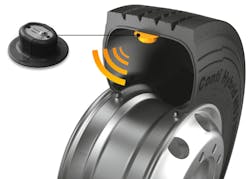Continental Embedded Tire Pressure Monitoring Sensor Technology Now Available as Factory Install Option
Continental announced updates to its tire pressure monitoring sensor installation process, now allowing fleets to spec tire-mounted tire pressure monitoring sensors on select new tires before they leave the factory.
The tire pressure monitoring sensors are embedded within the tire after the manufacturing of the unit, but before the tires leave the factory.
The factory-installed embedded TPMS sensor technology is available beginning in early September, starting with the Continental Conti Coach HA3 tire. “This is the first complete tire line in the industry that has a TPMS sensor from the factory,” Paul Williams, executive vice president, Continental, said.
All HA3 tires will come equipped with an embedded TPMS sensor. Tires with this embedded sensor will also include an “active sensor” mark for easy identification when mounted to the vehicle. Williams said Continental plans to eventually expand this factory-install tire-mounted sensor option to additional tires as well.
Previously, tire-mounted TPMS sensors were only a retrofit aftermarket option for Continental tires.
“The issue with retrofit - for a bus or truck operator, they’ll need to remove the tire from the unit and refit the sensor,” Williams explained. “It costs to dismount and mount the tire. This way, it’s a no brainer, (the tire has) got a sensor already included.”
This latest development expands the company’s tire program and TPMS technology options. Continental serves both the commercial vehicle and passenger vehicle markets. This crossover provides an integrated approach when it comes to sharing resources and knowledge between industries. Williams said Continental is one of the largest automotive suppliers in the industry, and that the company has produced more than 300 million TPMS sensors since 2002.
While passenger car market TPMS sensors have traditionally been valve-mounted, the design of Continental's tire-mounted sensor for commercial vehicles helps to protect the sensor from damage, theft and curbing.
According to Williams, the Continental TPMS sensor is designed to last for 600,000 miles, or about five to six years before replacement is necessary. Continental offers a device that can check battery life. Williams suggests fleets can opt to replace the sensors when a retread is completed.
As fleets continue to find ways to reduce operational costs, continued monitoring of tire pressure and temperature can help keep vehicle tires properly inflated and increase vehicle uptime. According to the Technology & Maintenance Council’s S.2 Tire & Wheel Study Group, properly inflated tires can help increase fuel efficiency by 1 percent, extend tread life by 15 percent and can account for up to 20 percent longer casing life.
Williams added the factory install embedded TPMS sensor option is designed to create a “push” effect on commercial fleets, to aid in the adoption and acceptance of more widespread tire pressure monitoring.
Options available for monitoring tires
Fleets utilizing the Continental TPMS sensors, regardless of factory or aftermarket fit, have the ability to monitor tire pressure and temperature through a number of monitoring options:
-
ContiConnect Yard - This system is set up to read tire sensor information as the sensor passes a threshold - for instance, when a bus arrives at a fleet terminal or the tractor-trailer returns to the yard. This system eliminates the need for manual tire pressure checks, but does not provide continual tire monitoring.
-
ContiPressureCheck - Provides the vehicle driver with real-time status of tire pressure and temperature through an in-cab mounted display.
-
ContPressureCheck and Telematics - In addition to the in-cab display, the system can utilize GPS-tracking functionality to access tire pressure and temperature information in real-time, through an on-site fleet portal. This capability is available through different GPS providers such as PeopleNet or Geotab.
